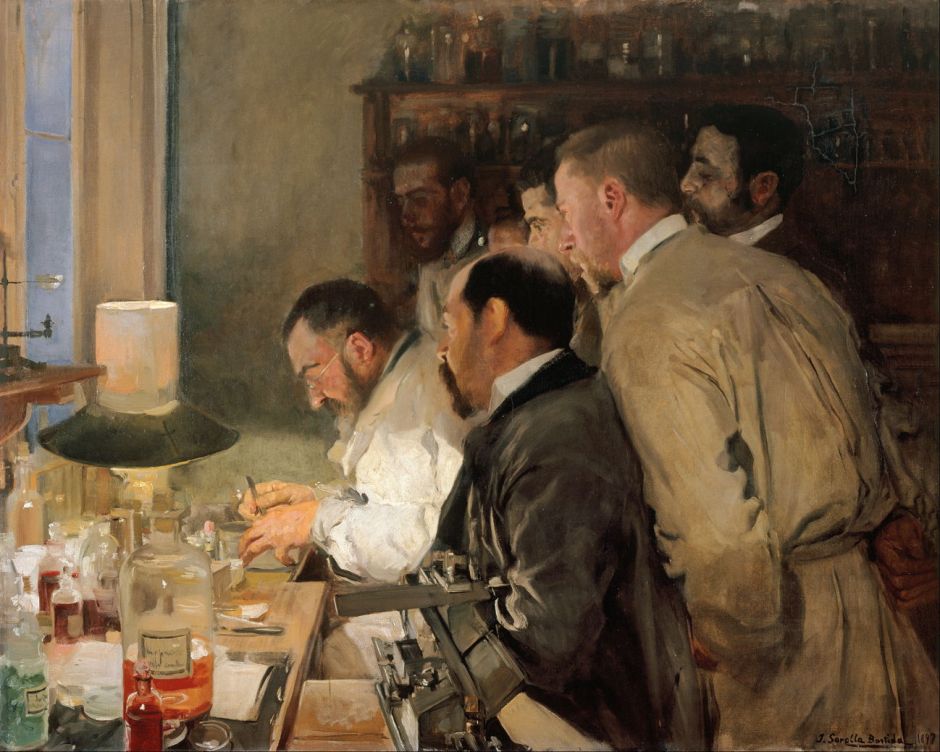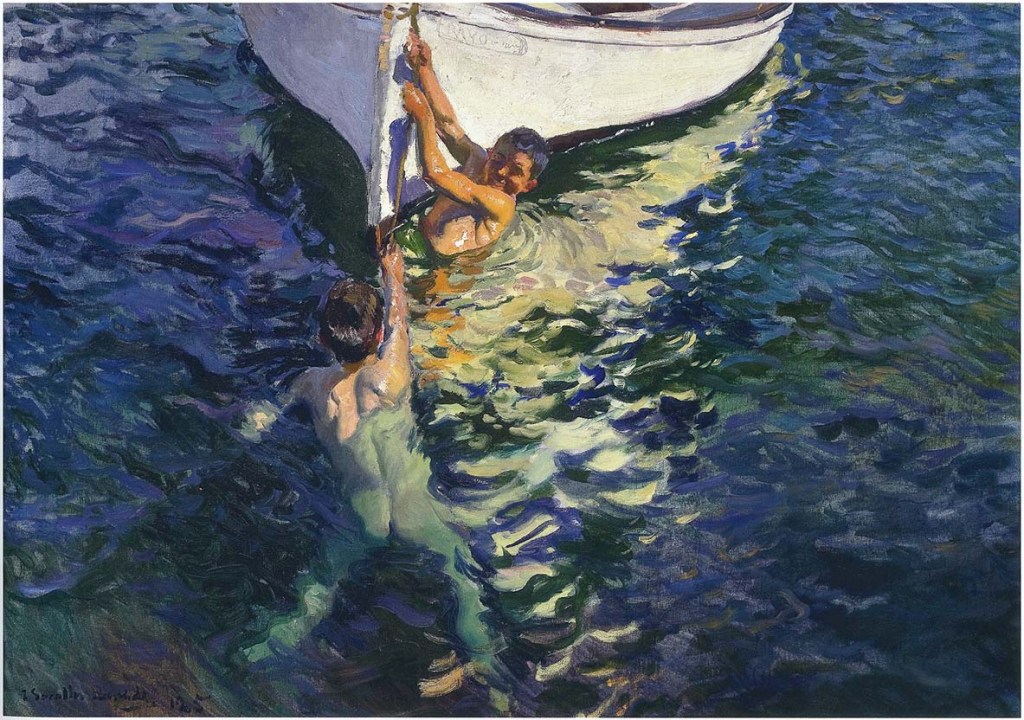At the Salon in Paris in 1895, Joaquín Sorolla y Bastida (1863–1923) had enjoyed continuing success with his Naturalist paintings, including his huge Return from Fishing (1894), which won him a gold medal, was bought by the French state, and now graces the Musée d’Orsay.

He continued to paint scenes from the working lives of fishermen in Valencia, including their shore maintenance tasks in Fishermen Taking up Nets (1896).

That year he also painted the better-known Sewing the Sail. This shows a scene on a patio at Valencia’s El Cabañal beach, during the Sorolla family holiday in the summer of 1896. Although it may look a spontaneous study of the effects of dappled light, Sorolla composed this carefully with the aid of at least two drawings and a sketch. It shows the whole family engaged in one of the more technically-challenging supporting tasks ashore.
This was exhibited the following year at the Salon in Paris, where it was praised, and went on to win first prizes in Munich and Vienna. Reaction was more mixed when it was shown in Madrid in 1899, but at the 1905 Venice Biennale it was bought by the city of Venice in recognition of its popularity there.

Although known primarily for his portraits and figurative works, Sorolla painted some fine landscapes, which may have had a more personal significance. The Cape of San Antonio, Jávea from 1896 shows this part of the southern end of the Gulf of Valencia, here from Cap Marti to the south.

His Portrait of Dr. Simarro at the Microscope from 1897 shows Doctor Luis Simarro Lacabra (1851-1921), who was an eminent psychiatrist in Madrid. He also undertook pioneering research looking at the fine structure of the brain. Among his many achievements was a modification of an established technique for staining microscopic sections of brain, which proved a major advance and an inspiration to the great Spanish neurohistologist Ramon y Cajal. This portrait was exhibited at the National Exhibition in Madrid that year.

Research, or under its original Spanish title of Una investigación o El Dr. Simarro en el Laboratorio, from the same year, goes on to look at Dr. Simarro at work in the laboratory among colleagues and students. He is here preparing specimens for microscopy, presumably using his staining technique. The table is covered with bottles of chemicals used in that process, and the chunky metal object in the centre foreground is a microtome, used for cutting very thin sections of tissue embedded in paraffin wax, prior to their staining, for study under the microscope.
These two paintings are probably Sorolla’s most floridly Naturalist works, celebrating contemporary advances in science, technology and medicine, in a documentary style.

Sorolla’s best-known painting from this Naturalist period is his large Sad Inheritance (1899), which won him the Grand Prix and medal of honour at the 1900 Exposition Universelle in Paris, and a medal in Madrid the following year. As ever, its apparent spontaneity is deceptive: this is one of his most carefully-prepared paintings.
This shows a group of young boys from a local charitable hospital enjoying a visit to the sea in the care of a ‘lone priest’, and celebrates the mission of the Hospitaller Order of St John of God, who had built the hospital in 1892 at the end of Malvarrosa Beach (Platja de la Malva-rosa), Valencia. Sorolla later said that he had witnessed this scene one evening in a remote corner of the beach, and once he had been given permission to paint the boys, he made an initial oil sketch from memory.
There’s considerable dispute over the cause of the boys’ disabilities. Sorolla’s title implies that they result from the ills of society, implying conditions such as congenital syphilis, and the consequences of parental alcoholism. More consistent with the period and their appearance, though, would be a mixture of preventable conditions including polio, which wouldn’t have fitted as well with the social message. Whichever was true, the implicit criticism made of the state left this remarkable Naturalist painting unsold, despite all its medals and awards.
In 1900 Sorolla made friends with John Singer Sargent, Giovanni Boldini, Anders Zorn, and PS Krøyer in Paris, and gave preparatory sketches for this work to Sargent and William Merritt Chase. He painted an increasing number of portraits, which were well received when exhibited in Madrid in 1901. In 1903 he was elected an academician in both Portugal and Spain.

Although Sad Inheritance was Sorolla’s last large Naturalist painting, he continued to create works in similar style. Lunch on the Boat, painted in the previous year, shows a group of Valencian men and boys eating an improvised lunch under the awning on their fishing boat.

His later large Afternoon Sun, Beaching the Boat (1903) is another scene of fishermen working hard with three teams of oxen to bring a fishing boat ashore, in the spirit of Return from Fishing.

In 1905, he travelled south from Valencia to paint another view of the rocky coast there, at Isla del Cap Marti, Jávea.

The White Boat, Jávea, with its skilful use of broken reflections and underwater views, came from the same summer campaign.
References
Véronique Gerard Powell (2019) Sorolla and ‘social painting’, in Sorolla, Spanish Master of Light, National Gallery and Yale UP, ISBN 978 1 85709 642 2.
Pons-Sorolla B (2012) Sorolla, the Masterworks, Skira. ISBN 978 0 8478 3933 9.

